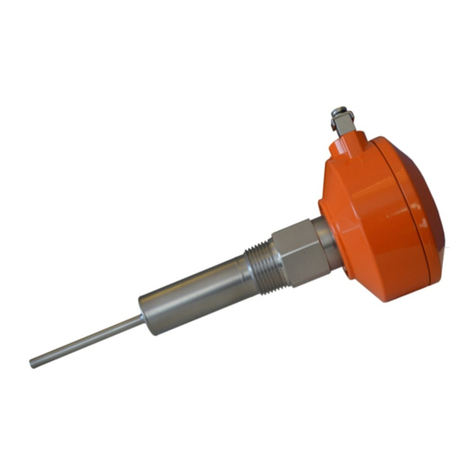
Mounting
The following has to be considered when mounting the DP660:
• The switching point of the DP660 depends on the density of the material: for heavy materials
only a few millimetres of the vibrating rod have to be covered for damping the vibration. For
light materials the material must cover the vibrating rod completely in order to damp its
vibration.
• The DP660 must not be mounted in or near the path of incoming material. The falling material
could damage the probe.
• In order to keep the ambient temperature of the PCB below 60°C the switch should be
protected from direct sunlight by installing a sun shield.
Side mounting or vertical mounting
• The DP660 can be mounted in the container either from the side or vertical from top or bottom.
• For side mounting it is recommended to screw the DP660 into the bin wall with the vibrating
rod pointing slightly downwards (approx. 20°) so that material can more easily flow and does
not rest on the vibrating rod.
• The DP660 must not be mounted in or near the path of incoming material. If this cannot be
avoided a protection shield, for example an angle steel with side length approx. 50mm, must
be installed approx. 150mm over the probe. A protection shield is necessary for low level
detection in order to protect the probe against falling material.
• The DP660 is installed by screwing the mounting thread into the bin wall with an open-end
wrench.
• A suitable sealing, (like Teflon tape), should be applied to the thread.
Orientation of the cable gland:
• The cable gland must always point downwards to prevent moisture seeping inside the
connector. The connector can get turned in 90° steps to keep the cable gland pointed
downwards. Push the connector block out of the plug, for wiring, and re-position it for the
required orientation.
Wiring
Safety Guidelines:
Wiring of these switches must only be performed by qualified technical personnel.
Before you start wiring make sure that power supply on all wires has been switched off.
In accordance with EN 61010-1 a main switch must be installed nearby with which power
supply and output signal can be switched off. This switch must be marked as main switch of
the unit.
The cables for power supply and output must be connected to the terminals according to the following sketch:
(cable cross-section max. 1,5mm²)
Relay-Output (SPST) 24V-Output
1 = Relay contact 1 1 = not connected
2 = Relay contact 2 2 = 24V output
3 = Power supply 24V DC or 24V AC (+/- 10%) 3 = Power supply 24V DC or 24V AC (+/- 10%)
4 = Ground 4 = Ground
The relay output can be used as 24V output by simply connecting Pin 3 to Pin 1, inside the plug.
The 24V output will then be on pin 2 when the switch is energised.
DP660 Instruction Manual Page 3
























